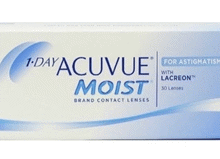What is Astigmatism?
Astigmatism refers to an irregularly shaped cornea that causes blurry vision. The cornea makes up the front of the eye and is typically rounded. In people with astigmatism, the cornea is curved outward giving it an oval or egg shape. This causes the way the eye process light to change and leads to blurry or distorted vision.
Astigmatic vision can be managed with glasses, contact lenses, and surgery. Being diagnosed with astigmatism and having it effectively treated can improve your quality of life and minimise the risk of complications. It is important to have a comprehensive eye exam regularly and to consult an optometrist if you notice new symptoms related to your eyes and vision.

Astigmatism Symptoms
Astigmatism affects people in different ways and in mild cases, it may not have any symptoms. Most commonly, it causes blurry or distorted vision, eyestrain, increased sensitivity to light and headaches. Blurry vision can be at any distance, as people with astigmatism may also be long or short-sighted. Light sensitivity may also lead to difficulties seeing (and driving) at night.
If you notice these symptoms, you should contact an optometrist and book a comprehensive eye exam.
Children will often not notice these symptoms. For parents and caregivers, it is important to look out for squinting, straining, eye irritation and frequent headaches.

How is Astigmatism Diagnosed?
Astigmatism can be diagnosed during a comprehensive eye exam. An optometrist may first identify the vision loss caused by astigmatism using a visual acuity test or diagnose it directly by measuring the curvature of the cornea or the eye's refractive error. During the eye exam, you will also be asked about the kind of symptoms you are experiencing, especially if you already think you may have the condition.
A refraction test allows an optometrist to diagnose astigmatism and identify which type of lens will be best suited to treating it. The test is carried out using an autorefractor and measures the way in which light bends and focuses as it passes through the eye. By observing how well you focus using different lenses, the test can also determine your prescription.
Astigmatism can also be diagnosed using keratometry by measuring the curvature of the cornea. By looking at the shape of your cornea, your optometrist can identify whether it is astigmatic or not,
Visual acuity tests and refraction tests are always carried out in a comprehensive eye exam. This is one of the many reasons to have your eyes regularly tested and to schedule an appointment if you notice specific symptoms.
Astigmatism Test: What to Expect
If you tell your optometrist you suspect you have astigmatism they will carry out a complete assessment of your vision and eye health. As well as determining whether or not you have astigmatism, they will calculate your prescription and offer you a recommendation about the best way to correct your vision.
To test for astigmatism, they will likely carry out a refraction test. Modern refraction tests commonly use a device called an autorefractor. During the test, you will be asked to look through the device and focus on an image or point of light. By passing a small amount of light through the eye, an optometrist can measure the refraction error of an eye. This enables them to determine whether or not you have astigmatism and calculate your prescription.
A keratometry test may also be carried out to measure the curvature of the cornea. These tests are quick and non-invasive. The patient simply has to look into a device called a keratometer, which will pass a beam of light over the eye, allowing the optometrist to determine the shape of the cornea and calculate the refractive error.
Comprehensive eye exams also include an examination of your interior and exterior eyes and some questions about your current health status and family history of eye conditions. This not only gives the optometrist a complete picture of your ocular health but allows them to tailor their recommendations to your specific requirements.
Treating Astigmatism with glasses
Glasses offer a simple and affordable way to correct astigmatic vision. Specialised types of lenses are used to correct the refractive error caused by the irregular shape of the cornea. The lenses can also correct long or short-sighted vision depending on your prescription.
The downside of glasses is that they are less effective at treating irregular astigmatism. This rarer form of astigmatism occurs when the curvature of the cornea is not uniform – this makes it more difficult to correct refractive errors using glasses. In this case, it may be necessary to look to other treatment options like contact lenses and surgery.

Contact Lenses for Astigmatism: Pros and Cons
Contact lenses are another common way to correct astigmatism. There are different types of lenses that may be recommended based on the type of astigmatism and the prescription.
There are several types of contact lenses that can be used to correct astigmatism, each of which has benefits and downsides.
Soft toric lenses are the only soft type of lens that can be used to correct astigmatism and long or short-sightedness. They are popular because they are simple to use, comfortable and come in daily and monthly disposable options. The main downside of soft toric lenses is they are less effective in correcting irregular astigmatism. They are also specifically shaped to correct the refractive errors of the eye, which means that if they shift or rotate blurry vision and other symptoms of astigmatism can return.
Rigid Gas Permeable (RGP) lenses can correct both regular and irregular astigmatism. These lenses work by directly reshaping the cornea and excellent vision. While extremely effective, these lenses can take more time to get used to and some find them to be less comfortable.
Hybrid lenses have a centre designed like an RPG lens while the outer rim is soft. This allows the wearer the benefits of the more effective RPG lenses while also providing greater comfort. However, hybrid lenses are often more expensive and must be replaced more frequently.
Surgical Options for Astigmatism
Surgery offers a long-term or even permanent solution to astigmatism. Refractive surgery can be carried out using different methods to reshape the cornea and correct astigmatic vision. As with all surgeries, there are risks associated with this treatment, but most refractive surgeries are successful.
Refractive surgery is generally carried out using lasers. Laser-assisted in-situ keratomileusis (LASIK), for example, uses two lasers two open a small section of the cornea and reshape it. Laser-assisted subepithelial keratectomy (LASEK), on the other hand, removes a section of the cornea’s covering and reshapes the cornea underneath, before replacing it.
Photorefractive keratectomy (PRK) is very similar to LASEK and uses the same procedure. The main difference is that the removed tissue is allowed to grow back naturally rather than replacing it.
New surgical options like Small-incision lenticule extraction (SMILE) are also becoming popular options. During SMILE surgery, a very small incision is made and a disk of tissue is created inside the cornea called a lenticule. When the lenticule is removed the cornea is reshaped fixing the refractive error of the eye. Because the incision in the cornea is so tiny, the surgery is thought to provide better results and fewer risks.
Phakic intraocular lens implantation (PIOL) is a type of surgery in which an artificial lens is applied just below the surface of the cornea. This allows the cornea to be reshaped and astigmatism corrected as though the patient was using contact lenses.
All of these surgical options provide successful results in the large majority of cases and serious complications are very rare. The most common issue with refractive surgery is that many patients need additional surgery or treatments to correct their astigmatism. This occurs in 1 in 10 cases (NHS, 2020). Other risks include dry eye, visual impairments (blurry or cloudy vision) and discomfort or the feeling of having something in your eyes. Infection and vision loss are very rare.
There are many benefits to refractive eye surgery, but it is important to discuss your options with an optometrist to find the best way to treat your astigmatism.
Tips for Managing Astigmatism: Eye Exercises and Protective Eyewear
It is not known precisely what causes astigmatism, though both genetic and environmental factors (like injuries or existing conditions) can contribute. Wearing protective eyewear while playing sports or carrying out hazardous tasks is always a good practice to protect your eyes from injury. Optometrists and eyewear retailers will usually supply a range of safety eyewear that can often be fitted with prescriptions if necessary.
If you are diagnosed with mild astigmatism, your optometrist will provide you with the best way to correct your vision and manage your symptoms, likely by using glasses or contact lenses. However, it is also thought that some eye exercises can help to reduce the symptoms of astigmatism. Taking regular breaks while reading, massaging the eyes, and exercising the muscles around the eyes may help to reduce eyestrain caused by astigmatism. This should not be considered a replacement for a clinical solution and if you have the symptoms of astigmatism you should always seek professional help.
How Astigmatism Affects Night Driving
Astigmatism causes blurry vision and light sensitivity, both of which can be more intense at night. The combination of low light and bright glare experienced while driving at night can be particularly difficult for people with astigmatism.
In low-light situations, the pupils will dilate allowing more light into the eyes. Because people with astigmatism cannot refract light properly this can increase blurry vision and distortions, especially when they periodically encounter bright or glaring lights. Sensitivity to these bright lights often causes people to squint, reducing their vision. The blurring and visual distortions like halos or light streaks also contribute to making it extremely difficult for people with astigmatism to see while driving at night. This reduced vision means the risk of an accident is much higher.

Tips for Night Driving with Astigmatism
While driving at night is more dangerous for people with astigmatism, there are several things you can do to improve your safety on the road.
- The most important is to stay up-to-date on your prescription. If you are using eyeglasses or contact lenses that are doing a good job of correcting your astigmatism, your symptoms will be reduced while driving at night. Your prescription can change over time, which is why having regular check-ups is also important. Avoiding looking directly at on-coming headlights can also help to prevent the visual distortions brought on by light sensitivity.
- There are also specialist glasses and contact lenses available designed to reduce glare during night driving. This helps to minimise the effects of bright lights and visual distortion.
- Another good tip is to ensure you have as much visibility as possible. This means keeping your windscreen clean and making sure your headlights are functioning.
- While it’s not always possible to avoid driving at night, it is a good idea to minimise long, difficult, or unfamiliar routes. If you do have to take a long trip, make sure to take plenty of breaks so you can rest your eyes.
Driving at night can be daunting for people with astigmatism. Nevertheless, by ensuring your vision is properly corrected you can help to improve your safety and that of the people around you.
References
NHS. (2020, 21 April). Laser eye surgery and lens surgery. https://www.nhs.uk/conditions/laser-eye-surgery-and-lens-surgery/




